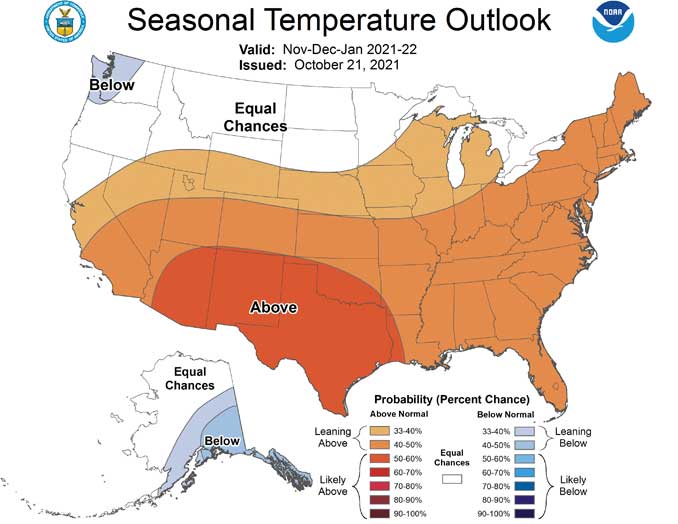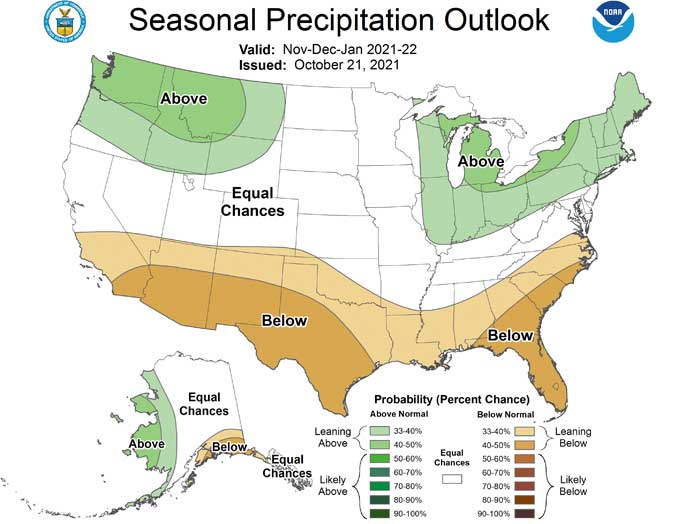
The National Weather Service Climate Prediction Center on October 21, 2021 issued “warmer outlooks” for Chicagoland for the 6-10 Day Outlook, the 8-14 Day, the November Outlook, and the Winter Seasonal Temperature Outlook (November, December, and January 2021-22).
December 2021-February 2022 Temperature Outlook from @NWSCPC #ilwx #inwx pic.twitter.com/a5BkTlpqUn
— NWS Chicago (@NWSChicago) October 21, 2021
December 2021-February 2022 Precipitation Outlook from @NWSCPC *Note: NOT a snowfall forecast #ilwx #inwx pic.twitter.com/epMcTBhAca
— NWS Chicago (@NWSChicago) October 21, 2021
The outlooks were reported after the National Oceanic and Atmospheric Administration (NOAA) announced on October 14, 2021 that a La Niña has developed and will extend through the second winter in a row according to NOAA’s Climate Prediction Center — a division of NOAA’s National Weather Service. La Niña is a natural ocean-atmospheric phenomenon marked by cooler-than-average sea surface temperatures across the central and eastern Pacific Ocean near the equator and is translated from Spanish as “little girl.”
La Niña Lake Arlington Sunrise …
During a recent La Nina — the 2010-2012 La Nina Event — Arlington Heights and the northwest suburb enjoyed a beautiful October in 2011 and a warm winter 2011-2012 season
La Niña is one part of the El Nino Southern Oscillation (ENSO) cycle, which is characterized by opposing warm and cool phases of oceanic and atmospheric conditions in the tropical Pacific Ocean. Consecutive La Niñas following a transition through ENSO neutral conditions are not uncommon and can be referred to as a “double-dip.” In 2020, La Niña developed during the month of August and then dissipated in April 2021 as ENSO-neutral conditions returned.
“Our scientists have been tracking the potential development of a La Niña since this summer, and it was a factor in the above-normal hurricane season forecast, which we have seen unfold. La Niña also influences weather across the country during the winter, and it will influence our upcoming temperature and precipitation outlooks.”
— Mike Halpert, Deputy Director of NOAA’s Climate Prediction Center
This La Niña is expected to last through the early spring 2022. For the upcoming winter season, which extends from December 2021 through February 2022, there is an 87% chance of La Niña.
Previous La Niña occurred during the winter of 2020-2021 and 2017-2018, and an El Nino developed in 2018-2019. When neither climate pattern is present, ENSO is neutral and does not influence global climate patterns.
During a La Niña year, winter temperatures are warmer than normal in the South and cooler than normal in the North. Only the extreme Pacific Northwest is associated with an outlook that is leaning below normal temperatures.


According to NOAA …
Widespread severe to exceptional drought continues to dominate the western half of the continental U.S., Northern Plains, and the Missouri River Basin.
Drought conditions are forecast to persist and develop in the Southwest and Southern Plains.
The Pacific Northwest, northern California, the upper Midwest, and Hawaii are most likely to experience drought improvement.
^^ MOBILE? USE VOICE MIC ^^
facebook …
Please ‘LIKE’ the ‘Arlington Cardinal Page. See all of The Cardinal Facebook fan pages at Arlingtoncardinal.com/about/facebook …
Help fund The Cardinal Arlingtoncardinal.com/sponsor
20240105-1435future
See also …
NOAA | Double-dip La Nina emerges
NOAA | U.S. Winter Outlook: Drier, warmer South, wetter North with return of La Nina


 Amazon Best Sellers in Audible Books
Amazon Best Sellers in Audible Books